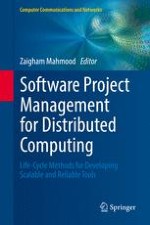This unique volume explores cutting-edge management approaches to developing complex software that is efficient, scalable, sustainable, and suitable for distributed environments. Practical insights are offered by an international selection of pre-eminent authorities, including case studies, best practices, and balanced corporate analyses. Emphasis is placed on the use of the latest software technologies and frameworks for life-cycle methods, including the design, implementation and testing stages of software development.
Topics and features:
· Reviews approaches for reusability, cost and time estimation, and for functional size measurement of distributed software applications
· Discusses the core characteristics of a large-scale defense system, and the design of software project management (SPM) as a service
· Introduces the 3PR framework, research on crowdsourcing software development, and an innovative approach to modeling large-scale multi-agent software systems
· Examines a system architecture for ambient assisted living, and an approach to cloud migration and management assessment
· Describes a software error proneness mechanism, a novel Scrum process for use in the defense domain, and an ontology annotation for SPM in distributed environments
· Investigates the benefits of agile project management for higher education institutions, and SPM that combines software and data engineering
This important text/reference is essential reading for project managers and software engineers involved in developing software for distributed computing environments. Students and researchers interested in SPM technologies and frameworks will also find the work to be an invaluable resource.
Prof. Zaigham Mahmood is a Senior Technology Consultant at Debesis Education UK and an Associate Lecturer (Research) at the University of Derby, UK. He also holds positions as Foreign Professor at NUST and IIU in Islamabad, Pakistan, and Professor Extraordinaire at the North West University Potchefstroom, South Africa.
